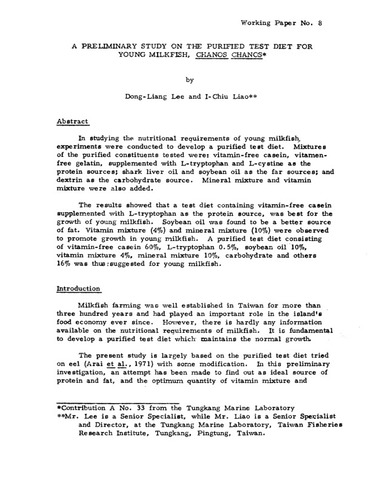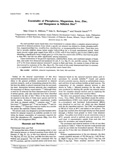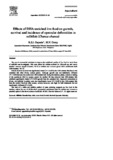| dc.contributor.author | Benitez, Lita V. | |
| dc.contributor.editor | Fortes, Romeo D. | |
| dc.contributor.editor | Darvin, Loureeda C. | |
| dc.contributor.editor | de Guzman, Dalisay L. | |
| dc.date.accessioned | 2011-06-22T09:35:14Z | |
| dc.date.available | 2011-06-22T09:35:14Z | |
| dc.date.issued | 1989 | |
| dc.identifier.citation | Benitez, L. V. (1989). Milkfish nutrition: a review. In R. D. Fortes, L. C. Darvin, & D. L. de Guzman (Eds.), Fish and crustacean feeds and nutrition : Proceedings of the seminar-workshop on fish and crustacean feeds and nutrition held on 25-26 February 1985 at UPV, Iloilo City (pp. 31-34). Laguna, Philippines: Philippine Council for Aquatic and Marine Research and Development. | en |
| dc.identifier.uri | http://hdl.handle.net/10862/313 | |
| dc.description.abstract | This paper reviews recent work on milkfish nutrition. Substantial progress had been made towards understanding the digestive physiology of milkfish. Major enzaymes envolved in the digestions of carbohydrates, protein and lipids had been detected in the pyloric caece, intestines and pancreas of milkfish. The most active carbohydrates were involved in the hydrolysis of α - glocosidic bonds. Intestinal amylase activity consistently reached the peak at about noon when milkfish gut was full. This confirms that milkfish is s daytime feeder. No cellulase activity was detected in any region orf the digertive treat although the fish relies heavily algae and other plant source for food.
Trypsin, chymotrypsin and general proteases were also detected in milkfish digestive tract. A powerful milkfish trypsin inhabitor was detected in the filementous algae, Chaetomorpha brachygona which is predominant species in lumot. Lipass in the pancreas and intestines had two pH optima, suggesting a physiologic versatility for lipid digestion in milkfish.
There is a limit information on the nutrient requirement of milkfish. Most studies showed that milkfish fry has a dietary requirement of 40% protein, and 7-10 lipid. Studies on the protein-energy requirement of fingerlings suggested that 30-40% protein, 10% fat and 25% carbohydrates are required. Subsequent studies showed an optimum protein energy to total metabolizable energy ratio of 44.4%. Amino acid test diets for milkfish had been formulated to contain white fish meal, gelatin and approprate amino acid mix. | en |
| dc.language.iso | en | en |
| dc.publisher | Philippine Council for Aquatic and Marine Research and Development | en |
| dc.subject | Chanos chanos | |
| dc.subject | South East Asia | |
| dc.subject | Philippines | en |
| dc.subject | milkfish | en |
| dc.subject.lcc | VF SP 104 | |
| dc.title | Milkfish nutrition: A review | en |
| dc.type | Conference paper | en |
| dc.citation.spage | 31 | |
| dc.citation.epage | 34 | |
| dc.subject.asfa | artificial feeding | en |
| dc.subject.asfa | brackishwater aquaculture | en |
| dc.subject.asfa | diet | en |
| dc.subject.asfa | fish culture | en |
| dc.subject.asfa | nutritional requirements | en |
| dc.subject.asfa | nutrition | en |
| dc.subject.asfa | digestion | en |
| dc.subject.asfa | milkfish culture | en |
| dc.citation.conferenceTitle | Fish and crustacean feeds and nutrition : Proceedings of the seminar-workshop on fish and crustacean feeds and nutrition held on 25-26 February 1985 at UPV, Iloilo City | en |
| dc.subject.scientificName | Chanos chanos | |



